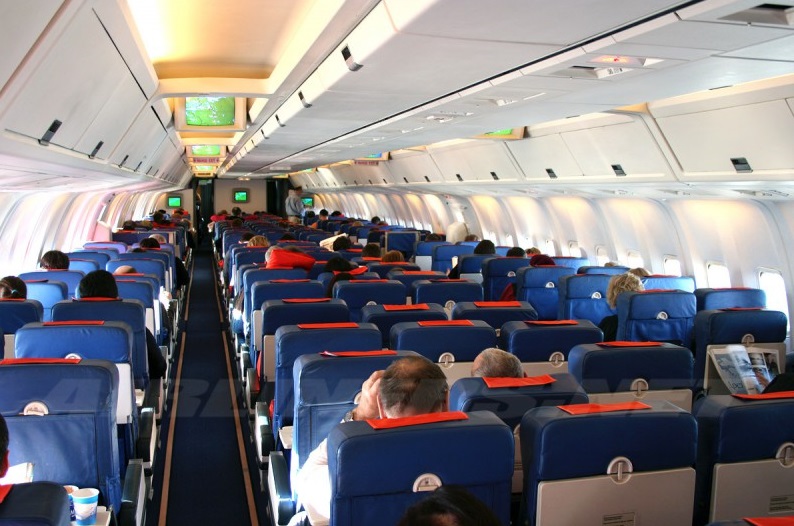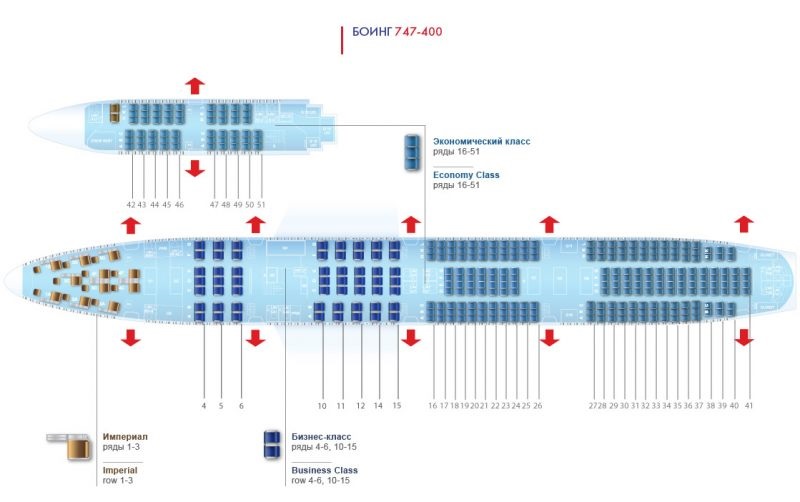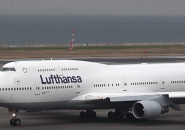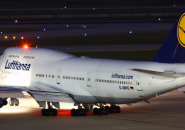Boeing 747-400. Photo. Video. Salon scheme. Characteristics. Reviews.
The four-engine Boeing 747-400 is a wide-body, long-haul, passenger aircraft built in a two-deck layout by Boeing Commercial Airplanes. This airliner, although designed on the basis of previous models of this family, is structurally a new aircraft. The new airliner has become much more spacious than previous versions of the Boeing 747 family. Thanks to the new engines, the noise level of the production Boeing 747-400 has become half that of the 747-300, and fuel efficiency has increased by 25 percent.
Boeing 747-400 photo
In early 1984, Boeing Commercial Airplanes began work on a new aircraft, due to the fact that the latest modification of the 747-300 did not raise sales as the company wanted. And on top of that, the problem was added in the form of developments of competing airliners, such as the McDonnell Douglas MD-11, Airbus A330 and Airbus A340, which in the future could take part of the market from Boeing. And in September of the same year, at the Farnborough Air Show, the creation of a new airliner, the Boeing 747 Advanced Series 300, was announced. Officially, the program was launched on October 22, 1985. The first customer for the new airliner was the American airline Northwest Airlines, whose initial order was for the supply of 10 aircraft. Later, the list of main customers expanded with such airlines as Cathay Pacific", Japan Airlines", Singapore Airlines", British Airways", "United Airlines", French "Air France" and German "Lufthansa". The main customers also acted as consultants in the design of the new airliner. After the approval of the project, the aircraft received the designation Boeing 747-400.
The wings were lengthened on the new aircraft, the span of which was now 64.44 meters, which is 4.8 meters more than the 747-300. Now the wings of the Boeing 747-400 began to be completed with wingtips, the so-called winglets. During the construction of the aircraft wing, composite materials were used, this had a positive effect on the weight of the structure. To increase the flight range, an additional fuel tank was installed on the aircraft.
The basis of the Boeing 747-400 power plant was the new economical Pratt & Whitney PW-4056 turbojet engines with a thrust of 252.4 kN. Later models also featured General Electric CF6-80-C2B1Fs, CF6-80-C2B1F1s engines and Rolls-Royce RB-211-524G engines with 258.0 kN thrust.
On the Boeing 747-400, new digital avionics was installed, consisting of six multifunctional displays and new on-board equipment. This decision allowed to reduce the crew to two people.
The upper deck has also been lengthened, now twice as long as on the original versions of the Boeing 747 family.
Boeing 747-400, in three classes, can accommodate 416 passenger seats. In the economy and business cabin configuration, 524 passengers can be accommodated. And in the maximum, economy class, the passenger capacity is 660 people.
The final assembly of the aircraft was carried out at the Boeing plant located in Everett. On January 26, 1988, when the aircraft rolled out of the assembly hangar, the company already had more than 100 orders for this aircraft.
And on April 29, 1988, a Boeing 747-400 took off. The first test flight lasted more than two hours. The tests involved four Boeing 747-400 aircraft, with different engines. And on January 10, 1989, the airliner received its first FAA flight certificate. On January 26 of the same year, the Boeing 747-400 was handed over to its first customer, Northwest Airlines. The first flight on this aircraft was made in the direction "Minneapolis - Phoenix", February 9, 1989.
Boeing 747-400 interior photo

Further work on the Boeing 747-400 led to the creation of such modifications as:
Boeing 747-400 F, a cargo version of the aircraft that first flew on May 4, 1993. This version is equipped with a nose cone that lifts up to provide access to the cargo hold.
Boeing 747-400 M Combi, combined, cargo-passenger version of the aircraft. The first flight on it was made on June 30, 1989. This version is equipped with a cargo hatch in the rear of the fuselage.
Boeing 747-400 ER, an extended range airliner. This aircraft was put into operation on October 31, 2002.
Boeing 747-400 D, a version designed specifically for Japanese airlines to operate on regional and local air routes. The first flight of this version took place on March 18, 1991.
Boeing 747-400 ERF, extended range air cargo version. The first aircraft of this version was handed over on October 17, 2002 to the French airline Air France.
In addition to civilian and cargo options, aircraft based on the Boeing 747-400 were also produced for military needs.
Boeing 747-400 became the best-selling aircraft of the entire 747 family. During the period of its production from 1988 to 2009, 694 units of this version of the air liner were produced. Of these, the basic passenger version 747-400, 442 aircraft were produced and delivered.

Technical characteristics of the Boeing 747-400 aircraft:
Years of production: from 1988 to 2009
Length: 70.67 m.
Height: 19.41 m.
Wingspan: 64.44 m.
Cabin width: 6.1 m.
Empty weight: 180985 kg.
Maximum takeoff weight: 362875 kg.
Wing area: 541.2 sq.m.
Cruise speed: 907 km/h
Maximum speed: 939 km/h
Ceiling: 13750 m.
Flight range: 13430 km.
Engines: 4 x Pratt & Whitney PW-4056 (252.4 kN), PW-4060s (266.9 kN), PW-4062s (275.8 kN), General Electric CF6-80-C2B1Fs (252.4 kN), CF6-80-C2B1F1s (273.6 kN), RollsRoyce RB- 211-524G(258.0 kN).
Crew: 2 people
Number of passenger seats: 660 seats in economy class
Boeing 747-400. Gallery.



